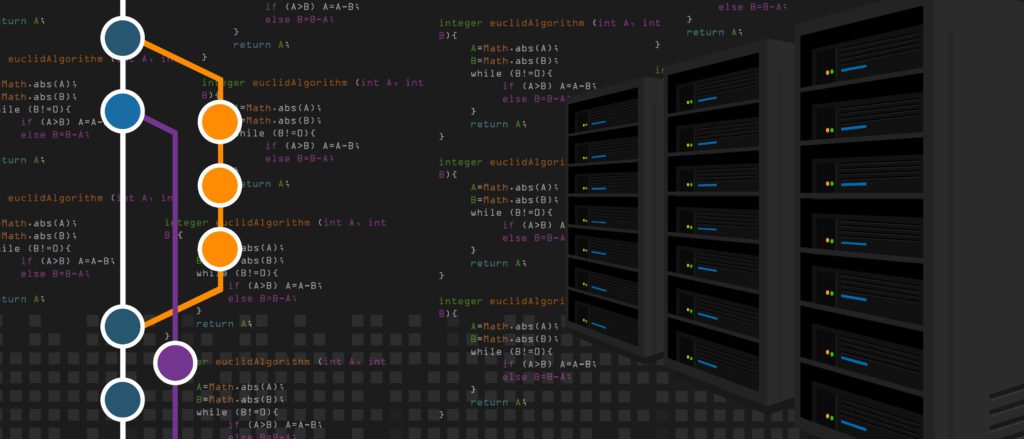
Git is largely considered to be the most widely used control system across the Internet. As an actively maintained open source project, Git is constantly being updated and improved, which contributes to its remarkable use throughout the development field.
When is Git Used?
Many software projects rely on Git for version control, or the processes and tools designed to keep track of multiple versions of software, content, and other information throughout website development. Where previously, websites had housed their most recent version history in a single place, Git offers a working copy of the code. This means that developers have access to a full history of every change made throughout a project.
Why Should I Use Git?
There are a variety of reasons to use Git. First of all, Git’s performance is tremendously higher than other market alternatives. This is due to a large variety of constantly changing features.
Branching and Merging
Git’s branching model differentiates it from other software configuration management systems by encouraging users to have multiple branches independent of one another. This allows you to experiment with a variety of changes to your site without having to fully commit entire branches of code to your newfound ideas. Additionally, because you can try out different features across branches, you can switch them back and forth and then delete individual branches when the feature is used in the mainline of your site.
Small and Fast
Git is known for being fast. Because all operations are performed locally, Git has a huge speed advantage on centralized systems. When you remove the need to communicate with a server somewhere, you end up with a much higher performing operation.
Distributed
One of the best features of any distributed software configuration management system is just that–it’s distributed. This means that you can clone an entire chunk of the code and work within just that piece, rather than having to adjust entire pieces of software at a time. This allows Git users to maintain multiple backups, an almost endless set of workflow options, and a centralized model in which all developers push to the same server.
Data Assurance
The data model that Git uses allows for major integrity throughout your project. In short, you cannot get anything out of Git that you did not put in. Additionally, it is not possible to change, edit, date, or recommit files in a Git repository without leaving an entire trail. Regardless of who makes the change, you’ll be up to speed with an exact history of who made the change, and when.
Staging Area
Git’s staging area, also known as its index, is an intermediate area where things can be formatted and reviewed before they become commits. This allows Git users to quickly stage their files and commit them without having to pull all files within their working directory or having to list them on the command line during the commit.
Free and Open Source
Git operates under the GNU General Public License version 2.0–an open-source license. An open-source license is a type of license that allows the code or design to be used and shared under predetermined terms and conditions. “This allows end-users and commercial companies to review and modify the source code, blueprint, or design for their own customization, curiosity, or troubleshooting needs.”
What is GitHub?

At this point, you may be beginning to feel that you’ve clarified your understanding around Git. However, you may still be asking, what is GitHub? You’ve come to the right place. Read on to learn more about GitHub and its role in allowing your web developers to code your website.
Understanding the Hub
We know that Git is a version control system. While Git is a command tool, GitHub is the center around which all of these tools revolve. Developers can store their projects in this hub and work through the challenges of their projects with other talented developers. Continue reading to learn why developers might choose to utilize the Hub when it comes to their ambitious Git projects.
Repository
A repository, or repo, is the location where all files are stored. These files can be accessed with a unique URL and can be used for “forking,” in which new projects are created from projects that already exist. This allows developers to adjust old projects and create new ones in order to constantly build on collective knowledge.
Pull Requests
If you’ve forked a repository and done something noteworthy to it, you can request a pull. By doing this, you offer the original developers of the repository to see your work and then decide whether or not they’d like it accepted into their project. This allows for collaboration between developers.
Social Networking
GitHub allows for a variety of social networking functions. Every Hub user has their own profile that serves as a sort of resume, that shows contributions to other projects throughout your time on GitHub. This allows for quick and seamless collaboration throughout GitHub.
Changelogs
With GitHub’s most critical features, change-tracking, multiple people can collaborate on a project with the confidence that all revisions will be tracked and stored to allow users to work in various editions of a project until their work is finalized.
Allow LightHouse Graphics to Manage Your Web Development Needs
Our web developers love nothing more than geeking out over endlessly editable web development programs. Don’t miss out on the opportunity to let them do what they love! Reach out to LightHouse Graphics today to discuss what our development team can do to enhance the website behind your business!


